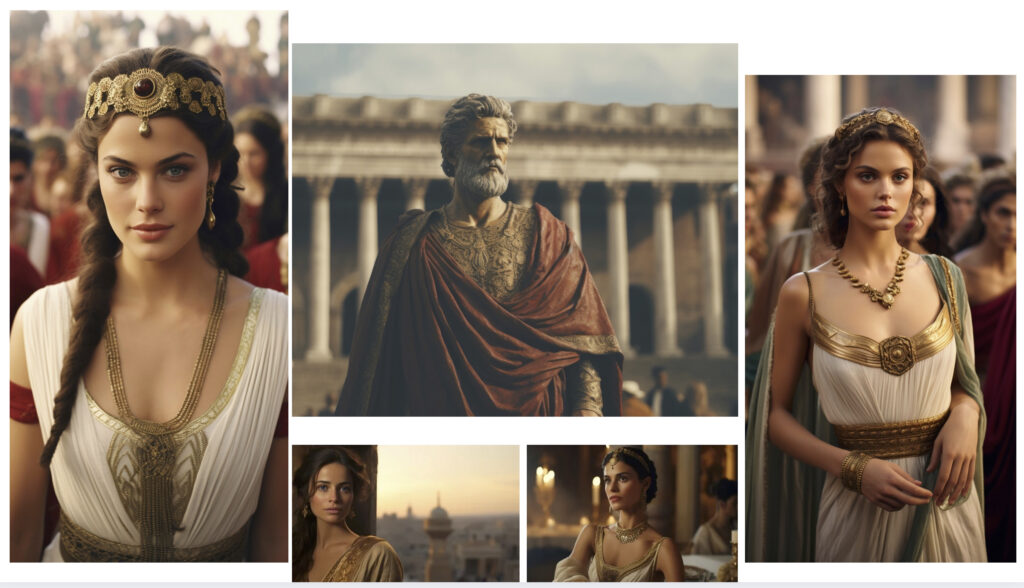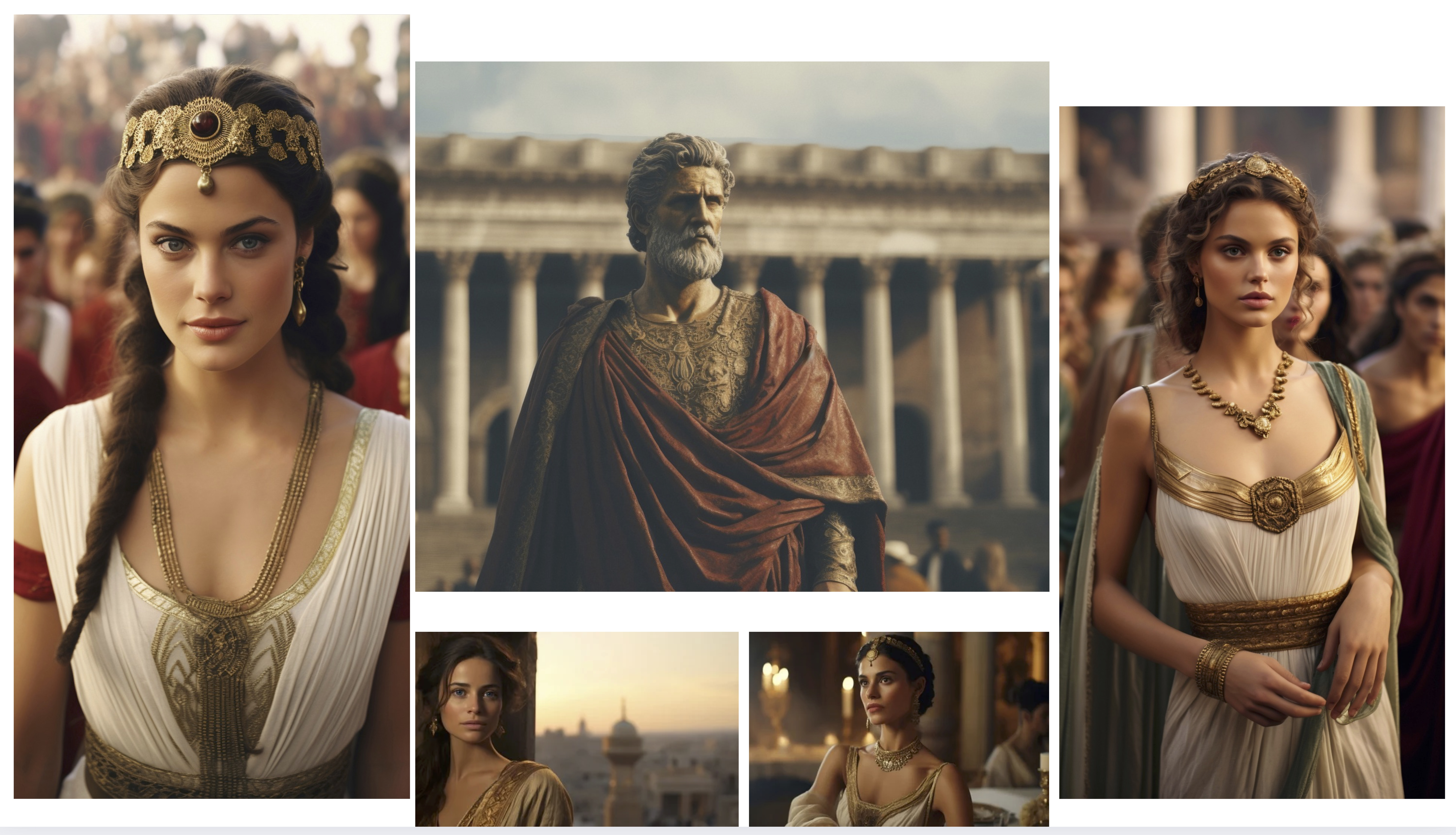Greek and Roman fashion established the aesthetic principles that continue to influence contemporary design. Their approach to dress embodied philosophical ideals about beauty, proportion, and the relationship between clothing and character.
“In marble and in cloth, Greece and Rome carved humanity’s silhouette upon eternity.”
– Dinis Guarda
In the marble-columned halls of Athens and Rome, fashion achieved philosophical sophistication that established aesthetic principles still governing contemporary dress. Greek and Roman fashion embodied ideas about beauty, proportion, and the relationship between clothing and character that transformed dress from mere social signalling into profound cultural expression.
Greek fashion celebrated the natural human form through masterful drapery that suggested rather than revealed, embodying Hellenic ideals about modesty, proportion, and the balance between concealment and display. The chiton and himation created fluid lines that seemed to capture the essence of Greek sculpture in textile form. Master drapers achieved effects comparable to the greatest artists, understanding that the careful arrangement of folds could create visual rhythms as sophisticated as those found in architecture or music.
Roman fashion transformed Greek elegance into an imperial statement, developing clothing that proclaimed not merely individual taste but the power and glory of the empire itself. The toga became the ultimate status symbol—its complex draping requiring both considerable skill and leisure time to maintain, immediately identifying its wearer as a citizen of sufficient means to engage in such time-consuming dress rituals. The toga’s eighteen feet of woollen fabric, when properly arranged, created a sculptural silhouette that transformed the wearer into a living embodiment of Roman dignity and authority.
Both cultures understood fashion’s power to enforce social order through visual means. Roman sumptuary laws regulated dress with the precision of military codes, specifying exactly who could wear what materials, colours, and styles. Purple, extracted from thousands of murex shells, was reserved for imperial use, making it the world’s first legally protected fashion element. These regulations established precedents for centuries of legally codified dress, demonstrating fashion’s power to maintain social hierarchies through visual means.
Greek Grace
Greek fashion celebrated the natural body through elegant drapery. The chiton and himation created fluid lines that suggested rather than revealed, embodying Greek ideals of modesty and beauty. The careful arrangement of folds became an art form, with master drapers achieving effects comparable to sculpture. Drapes also had practical benefits: it adapted to the warm climate, allowed freedom of movement, and could be adjusted for changing temperatures by adding or removing layers.
Roman Pragmatism
Rome transformed Greek elegance into imperial statement. The toga became the ultimate status symbol—its complex draping requiring both skill and leisure to maintain. Roman fashion innovations included the first fashion accessories industry, with elaborate fibulae (brooches) becoming collectible artworks that signalled wealth and personal taste.
Social Stratification
Both cultures used clothing to enforce social hierarchies. In Rome, sumptuary laws regulated who could wear what, with purple reserved for imperial use and specific garments mandated for different social classes. This legal codification of fashion established precedents for centuries of regulated dress.
Key Benchmarks
| Period | Culture | Innovation | Significance |
| 800 BCE | Greek | Draped garments | Natural body celebration |
| 500 BCE | Greek | Loom improvements | Finer fabric production |
| 200 BCE | Roman | Toga development | Imperial fashion symbol |
| 100 CE | Roman | Sumptuary laws | Legal fashion regulation |
| 400 CE | Roman | Christian influence | Religious fashion modesty |
Dinis Guarda – with Jasmeen Dugal
Dinis Guarda is an author, academic, influencer, serial entrepreneur, and leader in 4IR, AI, Fintech, digital transformation, and Blockchain. Dinis has created various companies such as Ztudium tech platform; founder of global digital platform directory businessabc.net; digital transformation platform to empower, guide and index cities citiesabc.com and fashion technology platform fashionabc.org. He is also the publisher of intelligenthq.com, hedgethink.com and tradersdna.com. He has been working with the likes of UN / UNITAR, UNESCO, European Space Agency, Davos WEF, Philips, Saxo Bank, Mastercard, Barclays, and governments all over the world.
With over two decades of experience in international business, C-level positions, and digital transformation, Dinis has worked with new tech, cryptocurrencies, driven ICOs, regulation, compliance, and legal international processes, and has created a bank, and been involved in the inception of some of the top 100 digital currencies.
He creates and helps build ventures focused on global growth, 360 digital strategies, sustainable innovation, Blockchain, Fintech, AI and new emerging business models such as ICOs / tokenomics.
Dinis is the founder/CEO of ztudium that manages blocksdna / lifesdna. These products and platforms offer multiple AI P2P, fintech, blockchain, search engine and PaaS solutions in consumer wellness healthcare and life style with a global team of experts and universities.
He is the founder of coinsdna a new swiss regulated, Swiss based, institutional grade token and cryptocurrencies blockchain exchange. He is founder of DragonBloc a blockchain, AI, Fintech fund and co-founder of Freedomee project.
Dinis is the author of various books. He has published different books such “4IR AI Blockchain Fintech IoT Reinventing a Nation”, “How Businesses and Governments can Prosper with Fintech, Blockchain and AI?”, also the bigger case study and book (400 pages) “Blockchain, AI and Crypto Economics – The Next Tsunami?” last the “Tokenomics and ICOs – How to be good at the new digital world of finance / Crypto” was launched in 2018.
Some of the companies Dinis created or has been involved have reached over 1 USD billions in valuation. Dinis has advised and was responsible for some top financial organisations, 100 cryptocurrencies worldwide and Fortune 500 companies.
Dinis is involved as a strategist, board member and advisor with the payments, lifestyle, blockchain reward community app Glance technologies, for whom he built the blockchain messaging / payment / loyalty software Blockimpact, the seminal Hyperloop Transportations project, Kora, and blockchain cybersecurity Privus.
He is listed in various global fintech, blockchain, AI, social media industry top lists as an influencer in position top 10/20 within 100 rankings: such as Top People In Blockchain | Cointelegraph https://top.cointelegraph.com/ and https://cryptoweekly.co/100/ .
Between 2014 and 2015 he was involved in creating a fabbanking.com a digital bank between Asia and Africa as Chief Commercial Officer and Marketing Officer responsible for all legal, tech and business development. Between 2009 and 2010 he was the founder of one of the world first fintech, social trading platforms tradingfloor.com for Saxo Bank.
He is a shareholder of the fintech social money transfer app Moneymailme and math edutech gamification children’s app Gozoa.
He has been a lecturer at Copenhagen Business School, Groupe INSEEC/Monaco University and other leading world universities.












